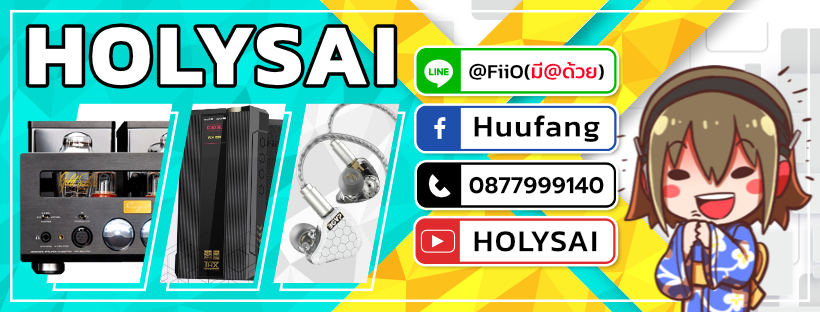ขาย Topping D30 DAC ตั้งโต๊ะชุดใหญ่ชิป Cirrus CS4398 รองรับ DSD Hi-res
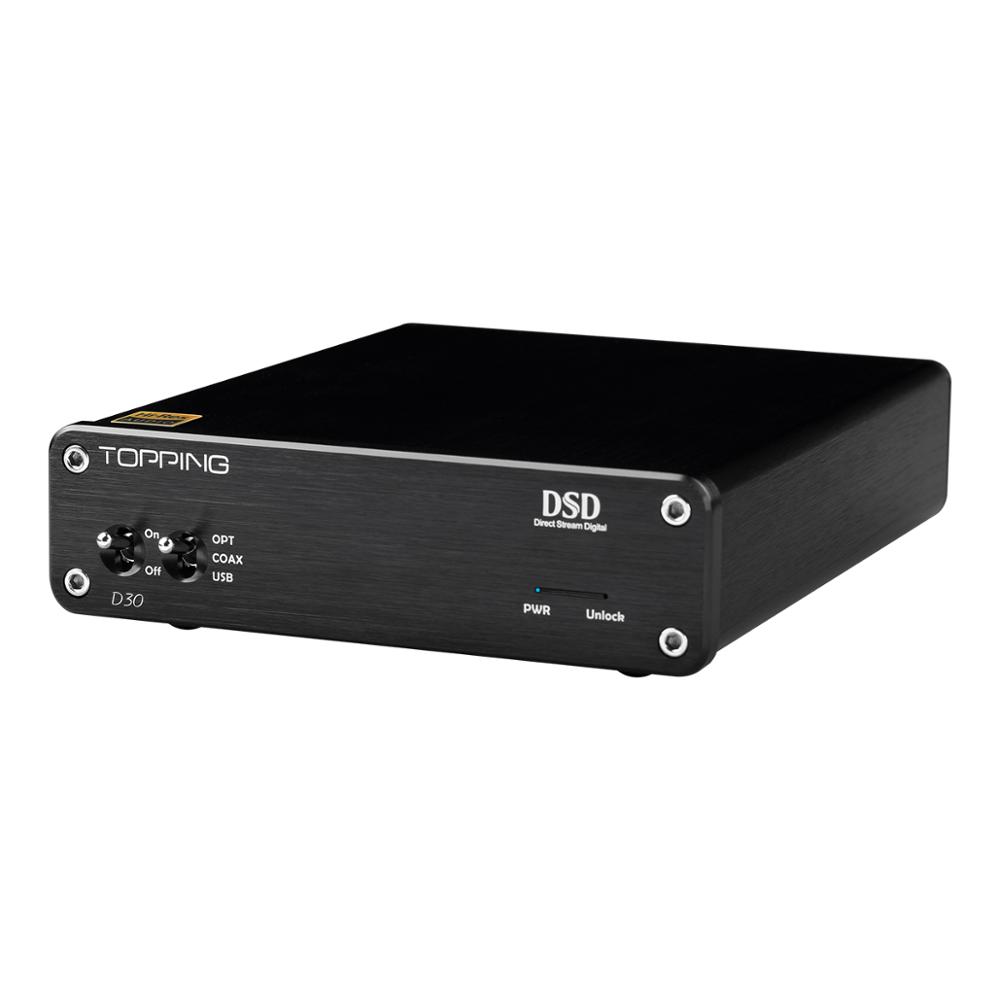

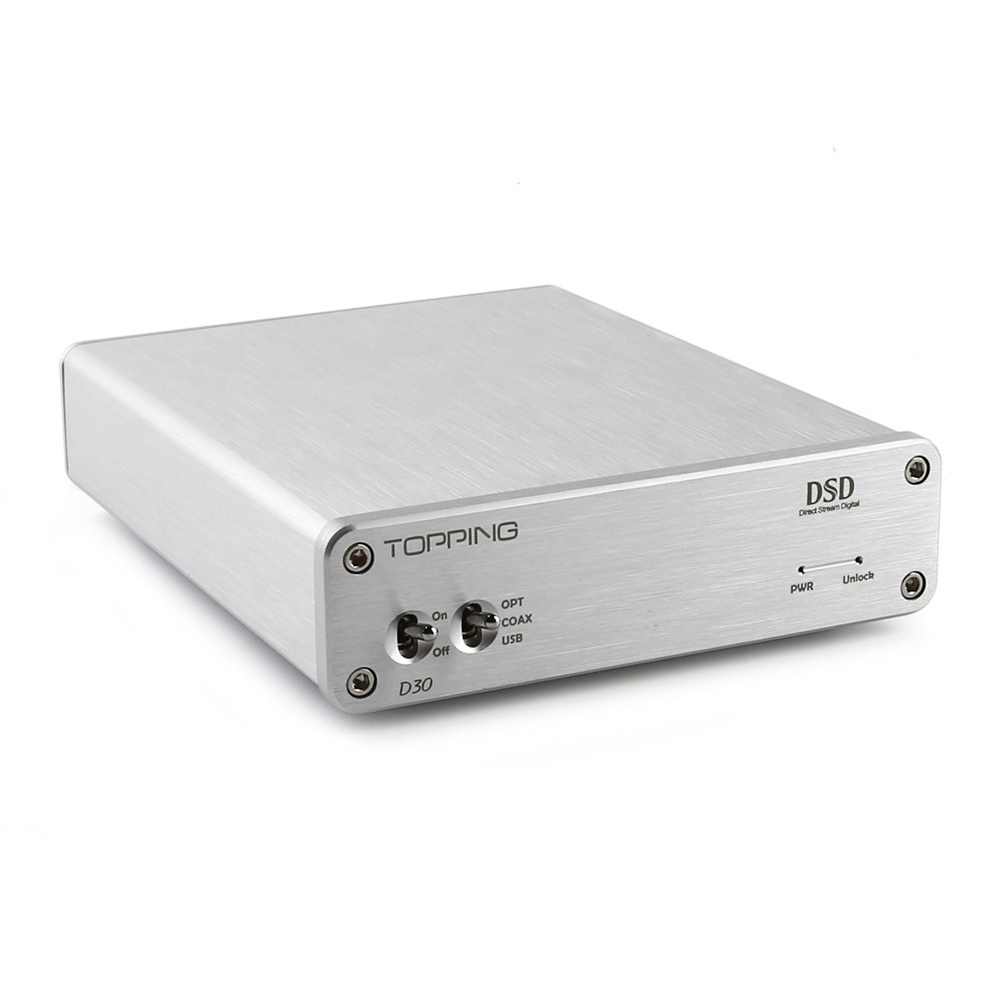
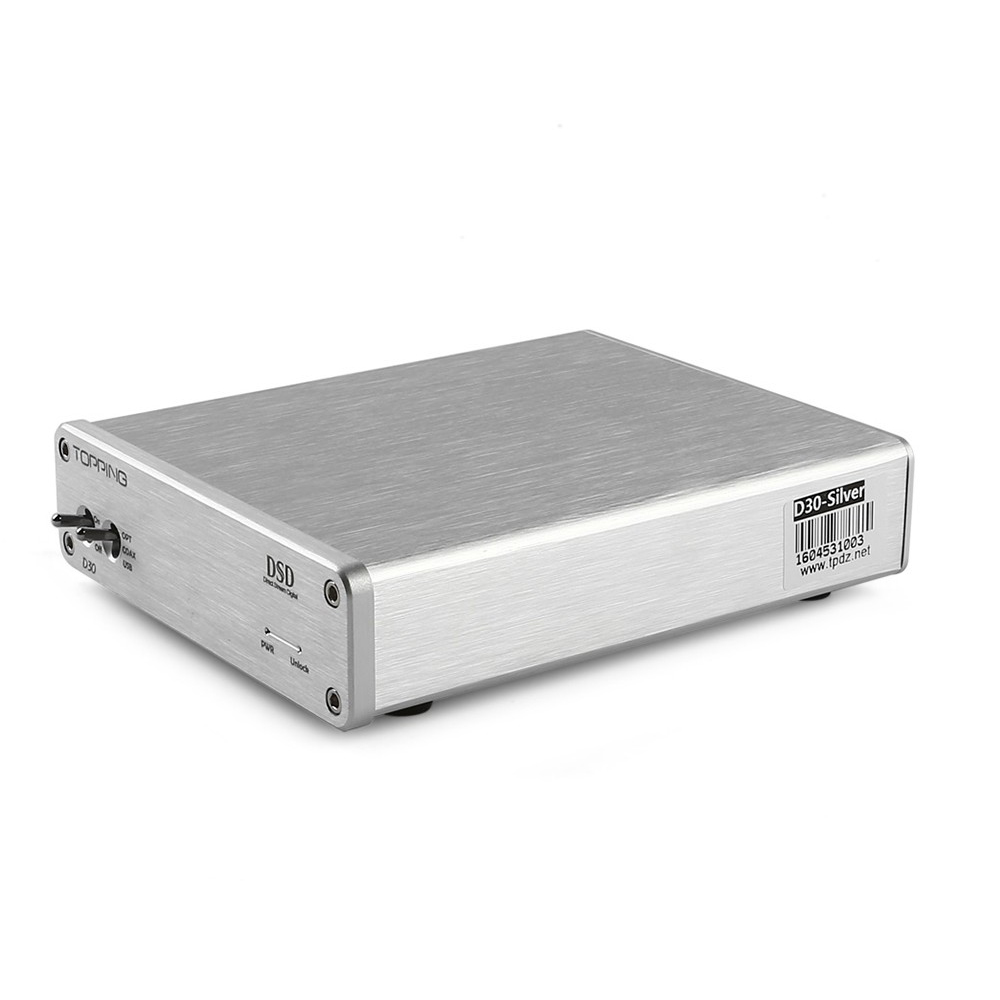
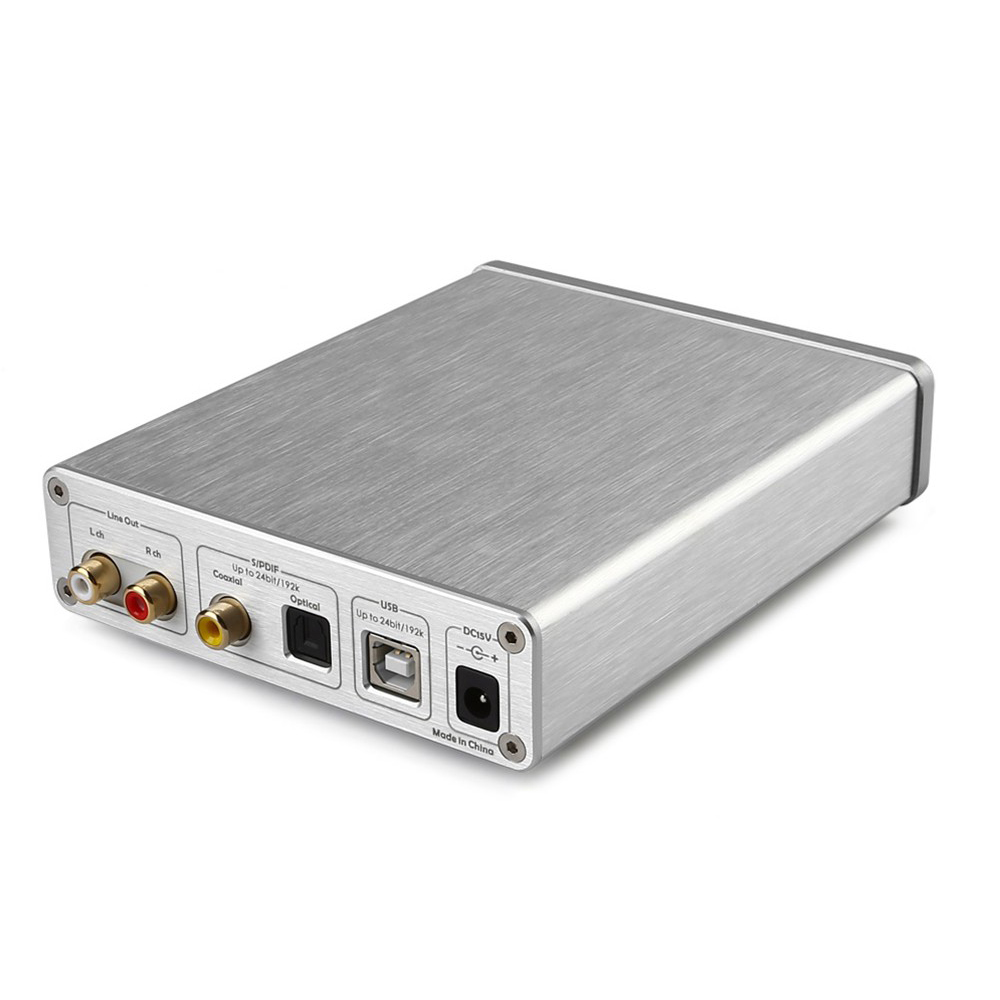
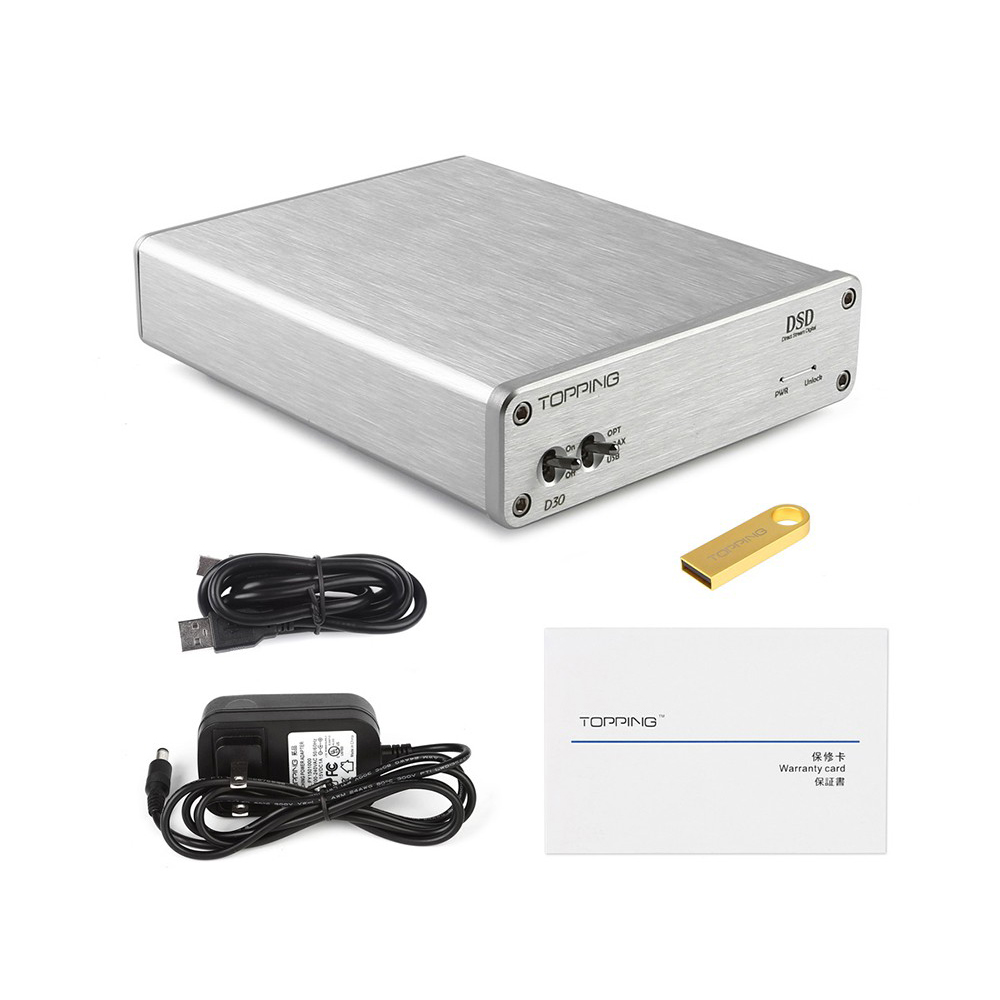
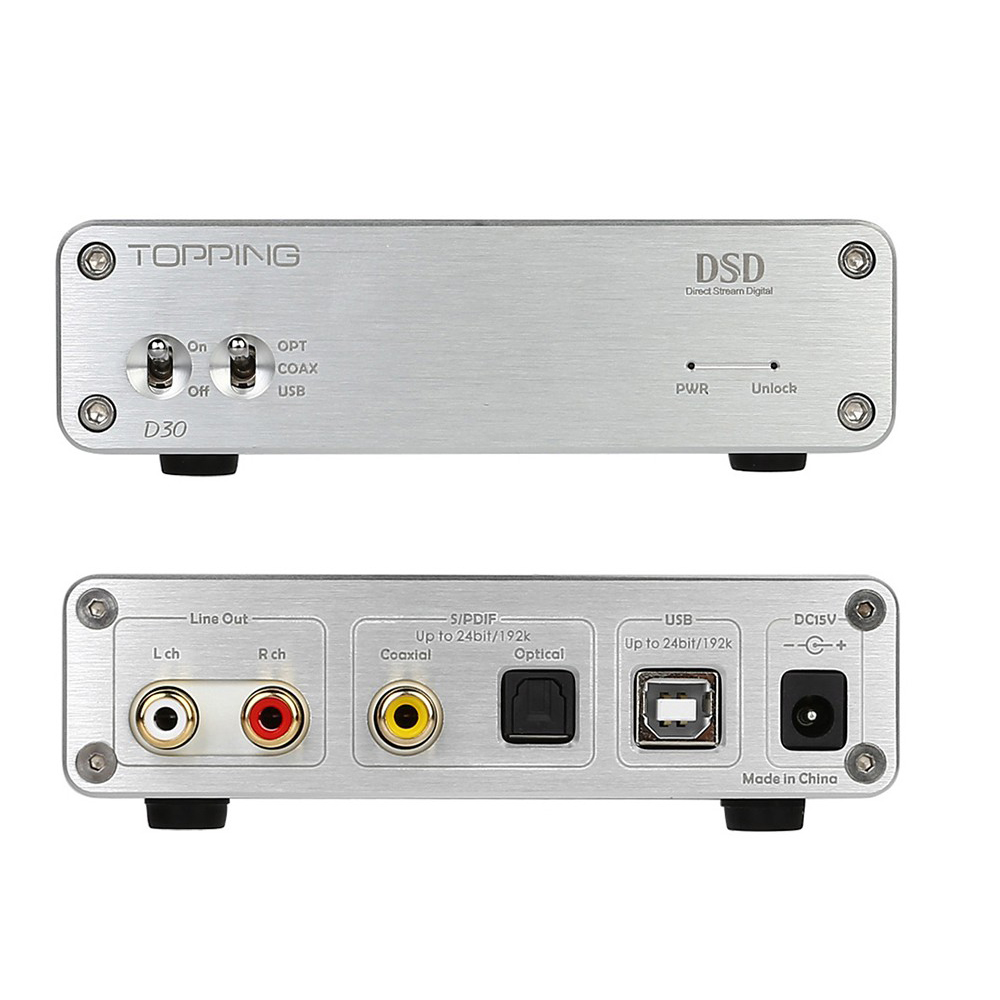
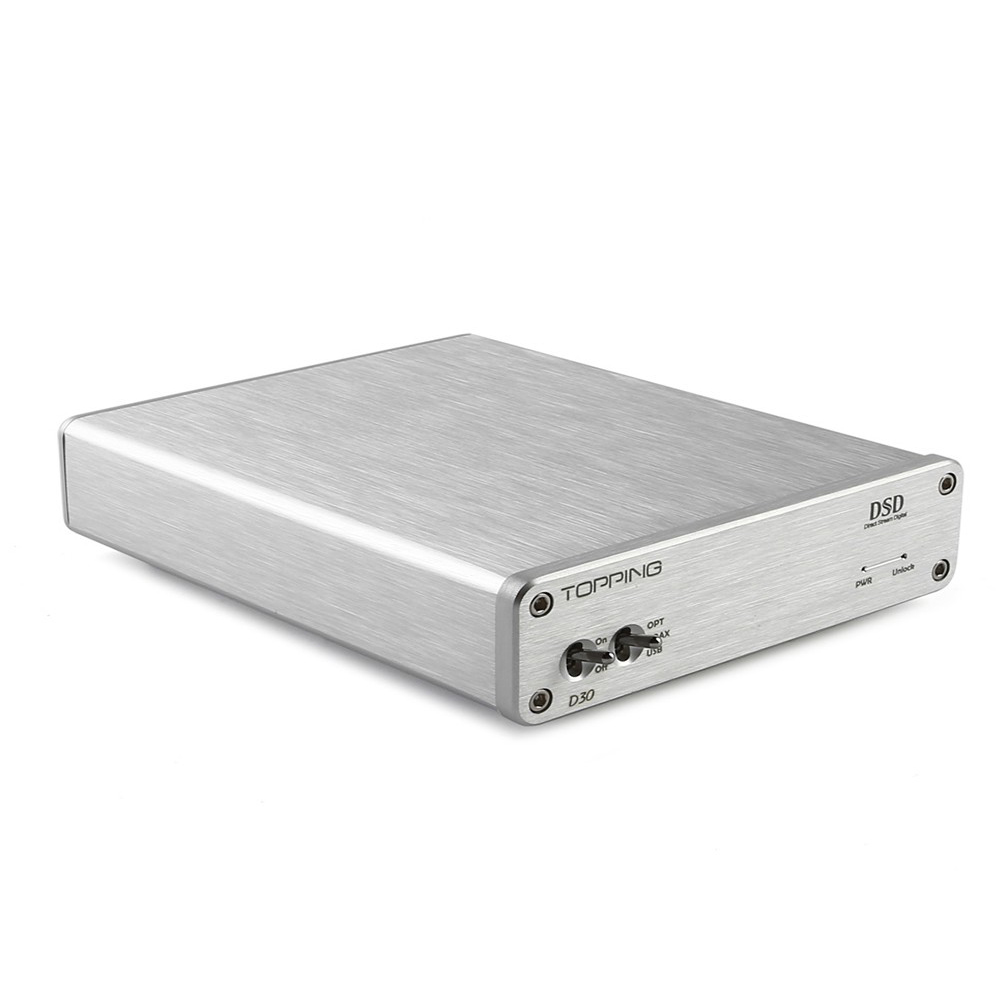
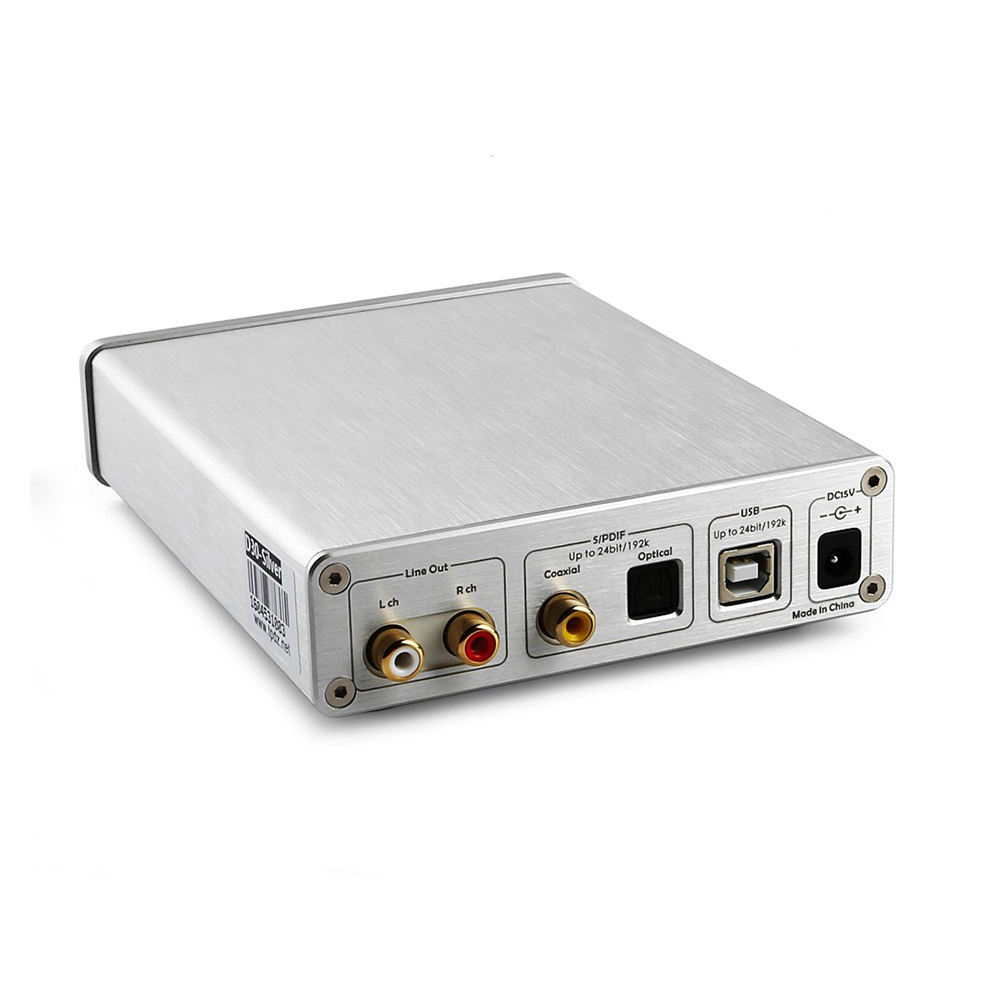
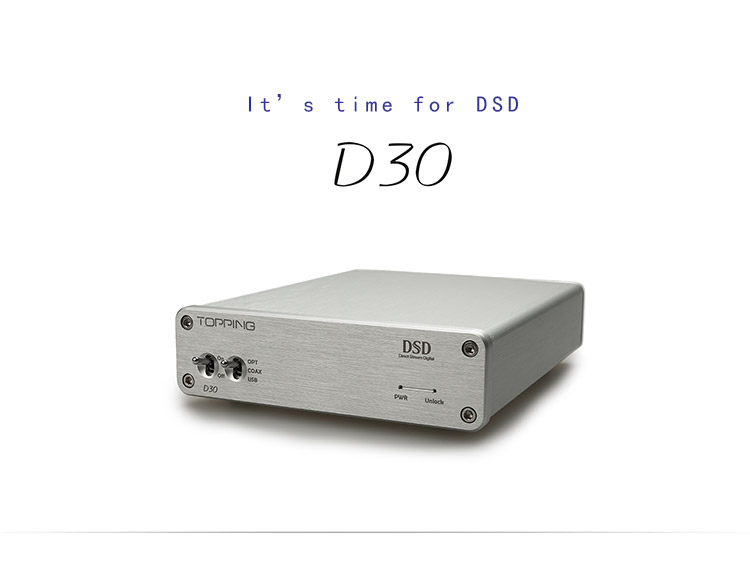


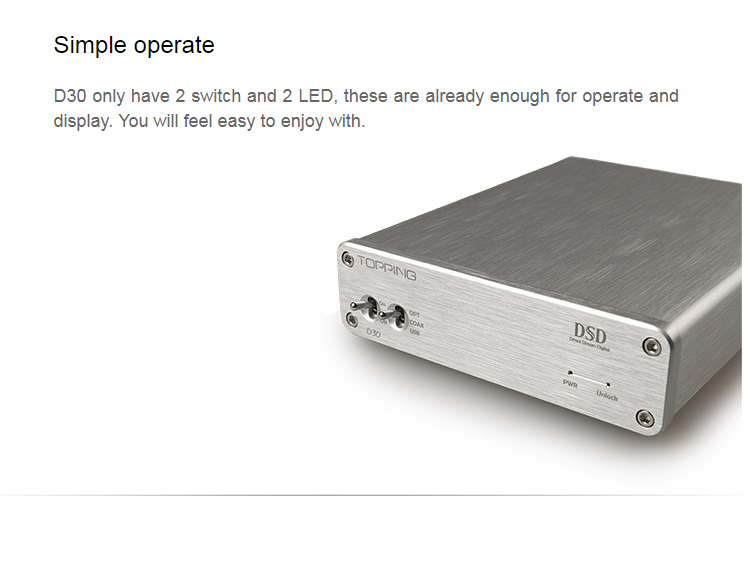
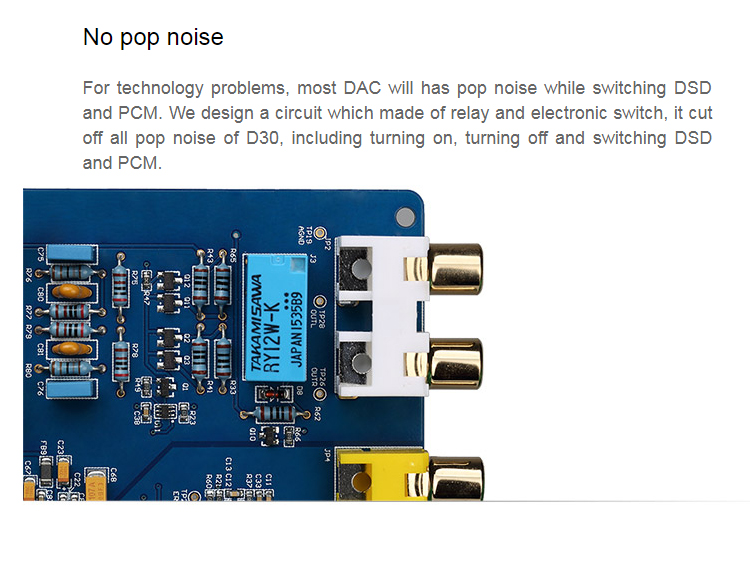


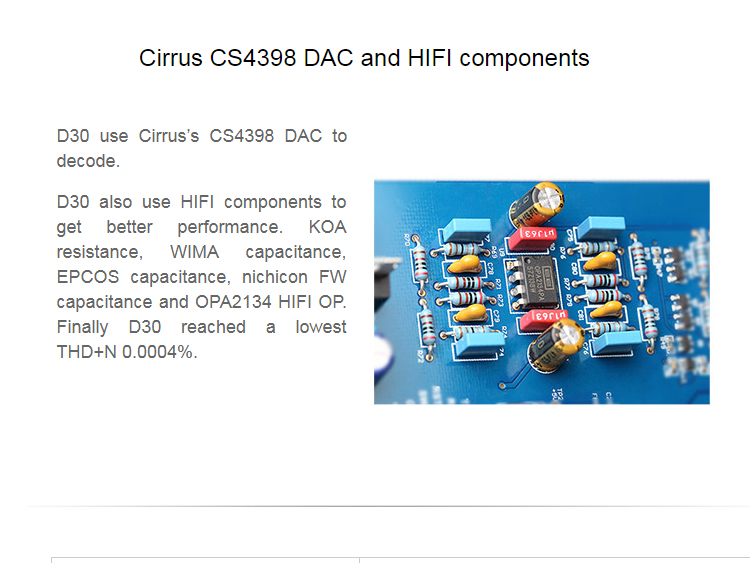
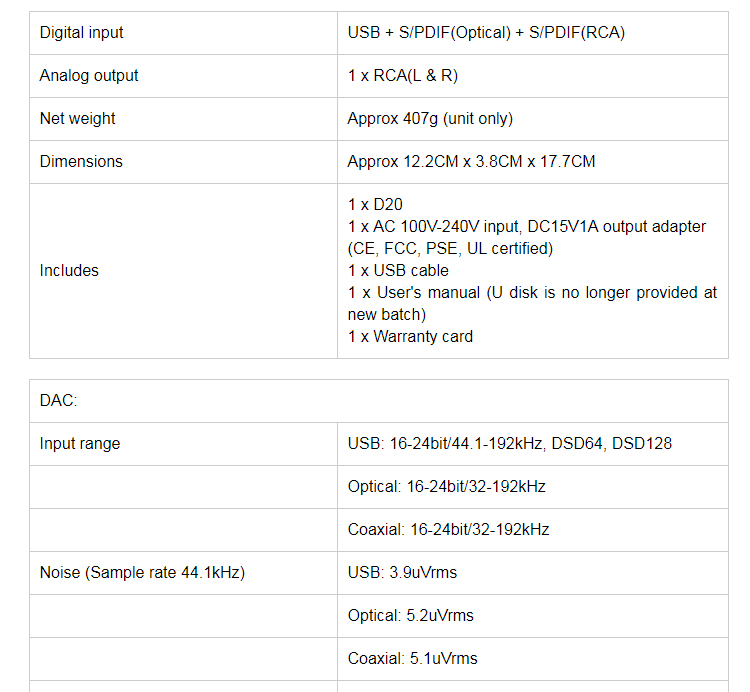
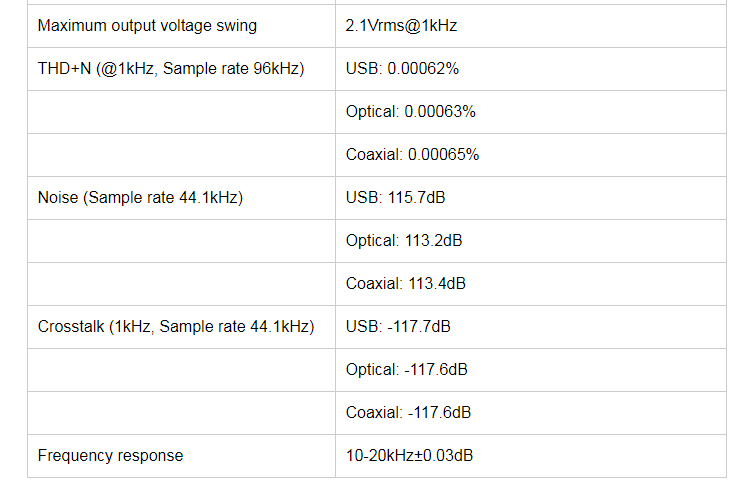
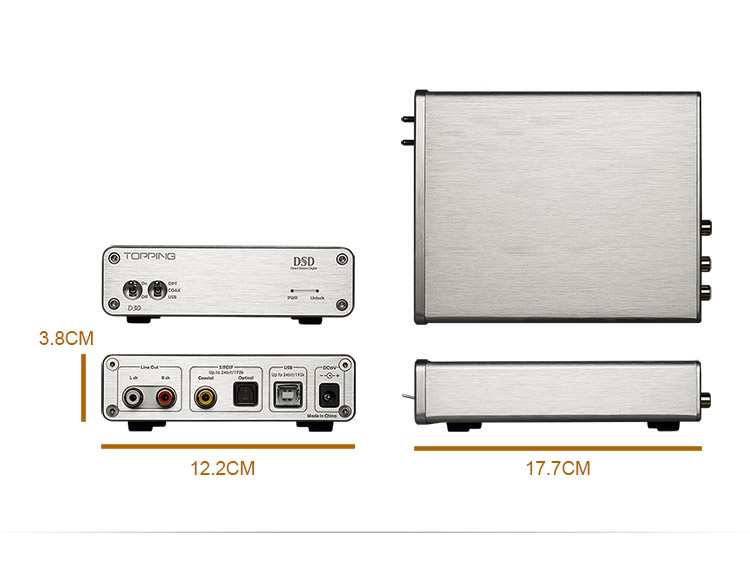
| รหัสสินค้า | SKU-03248 |
| หมวดหมู่ | FiiO DAC + USB DAC |
| ราคา | 4,490.00 บาท |
| ลงสินค้า | 9 ก.ค. 2563 |
| อัพเดทล่าสุด | 4 มิ.ย. 2564 |
| คงเหลือ | 0 ชิ้น |
| Topping D30 สีดำ 
เลิกจำหน่าย | Topping D30 สีเงิน 
เลิกจำหน่าย |
รายละเอียดสินค้า

Topping D30
DAC ตั้งโต๊ะชุดใหญ่ชิป Cirrus CS4398 รองรับ DSD Hi-res
ราคา 4,490 บาท
ประกันศูนย์ไทย 1 ปี ตามเงื่อนไขการรับประกัน

Topping D30
คือDAC ตั้งโต๊ะชุดใหญ่ที่ใช้ชิป Cirrus CS4398 รองรับ DSD Hi-res
จุดเด่นของเครื่องอยู่ที่เลือกใช้แต่ชิ้นส่วนระดับ HIFI เช่น ชิป OPA2134 HIFI OP
สัญญาณรบกวนและความผิดเพี้ยนต่ำกว่า 0.0004% ไม่มีเสียง POP Noise มากวนใจ
ตัวเครื่องครอบคลุมการใช้งานทั่วไปรองรับ input หลากหลาย
ทั้ง USB , Coaxial , Optical ก็รองรับ สามารถใช้งานได้อย่างง่ายดายไม่ยุ่งยาก
บอดี้ทำจากอลูมีเนียมไร้รอยต่อ ตัวหนังสือคมชัดผ่านการยิงเลเซอร์มาอย่างดี
สินค้ามีจำหน่ายทั้งหมด 2 สี
สีดำ / สีเงิน
กรุณาเลือกสีตอนสั่งซื้อสินค้า

ข้อมูลสินค้าเบื้องต้น
ใช้ชิป DAC Cirrus CS4398
ใช้ชิป XMOS
ใช้ OP AMP OPA2134
รองรับ DSD64 , DSD128 , 24bit/192kHz
รอบรับ ASIO audio software interface
รองรับ Input ทั้ง USB , Coaxial และ Optical Fiber
Input range อยู่ที่ 16-24bit/44.1-192KHz
ใช้ตัวต้านทาน KOA จากญี่ปุ่น
ใช้ตัวเก็บประจุจากเยอรมัน
รองรับ DSD
รองรับ Hi-Res
ไม่มีเสียง Pop Noise รบกวน
บอดี้อลูมีเนียมไร้รอยต่อ

รองรับ DSD ดียังไง ?
DSD (Direct Stream Digital) เป็นไฟล์เพลงระดับไฮเอนด์
ซึ่งถูกตั้งขึ้นโดย Sony และ Philips ซึ่งปัจจุบันไฟล์แบบ DSD
นั้นเป็นที่นิยมมากขึ้นในหมู่นักเล่น
เพราะให้คุณภาพเสียงดีกว่าไฟล์เพลงทั่วไป
ดังที่เห็นว่าเครื่องเล่นเพลง DAP ระดับไฮเอนด์สมัยใหม่
ส่วนมากจะรองรับ DSD หมดแล้ว
นั่นหมายความว่า FiiO X3 ใหม่สามารถรองรับไฟล์ทั่วไป
อย่าง .MP3 ไปจนถึงไฟล์แห่งอณาคตอย่าง DSD เลยทีเดียว

รองรับทั้ง DSD64 และ DSD128
ค่า sampling rate ที่สูงกว่าระบบเก่าโดยมีค่าตั้งแต่ 2.8224MHz และ 5.6448MHz
ในขณะที่รุ่นเก่าทำได้ 44.1kHz ซึ่งรายละเอียดเสียงจะมีมากกว่าแบบเก่า

รองรับ input หลากหลาย
ครอบคลุมการใช้งานทั่วไปทั้ง Coaxial , Optical รองรับที่ 16-24bit/44.1-192kHz
ในส่วนของ USB รองรับ DSD64/DSD128 (DoP or ASIO Native)

ใช้งานง่ายไม่ยุ่งยาก
ตัวเครื่องถูกออกแบบมาให้ใช้งานได้ง่ายโดย จะมี 2 สวิ้ต และไฟแสดงผลแบบ LED 2 ดวง
สวิ้ตฝั่งซ้ายใช้เปิดปิด ส่วนฝั่งขวาใช้เลือกว่าจะใช้งานแบบ Optical , Coax หรือ USB

ไม่มีเสียง Pop Noise รบกวน
DAC ทั่วไปเวลาสลับการทำงานระหว่าง DSD และ PCM จะเกิดเสียง Noise
แต่ด้วยเทคโนโลยีของ Topping D30 ที่ดีไซน์แผงวงจรขึ้นมาใหม่ซึ่งเลือกใช้ relay
กับ สวิ้ตแบบใหม่ทำให้ตัดเสียง Pop Noise ได้หมด ไม่ว่าจะเปิดปิดหรือสลับการทำงาน

บอดี้อลูมีเนียมไร้รอยต่อ
ผลิตด้วยเครรื่องจักรทันสมัย ตัวอักษรยิงด้วยเลเซอร์ความเข้มสูง

รองรับ DSD64 , DSD128 , 24bit/192kHz
รุ่นนี้ใช้ชิปจากค่าย XMOS ที่มีชื่อเสียงในด้านสัญญาณรบกวนที่ต่ำมาก
นอกจากนี้ยังรอบรับ ASIO audio อีกด้วย

เลือกใช้แต่ชิ้นส่วนระดับ HIFI
มีทั้งชิป Cirrus CS4398 ซึ่งใช้ในการถอดรหัสเสียงที่รองรับ DSD Hi-res
ตัวต้านทานจากค่าย KOA ตัวเก็บประจุจากค่าย WIMA , EPCOS , nichicon FW
และใช้ชิป OPA2134 HIFI OP ซึ่งมีสัญญาณรบกวนและความผิดเพี้ยนต่ำกว่า 0.0004%


ข้อมูลสินค้าเพิ่มเติม

ขนาดของสินค้า

ภาพสินค้าเพิ่มเติม





--------------------------------------------------------------------------------
Reviews Topping D30
โดยคุณ drteming

Inside the plain box:
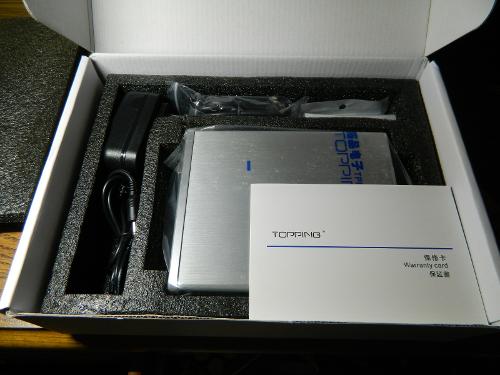
Out of the box:
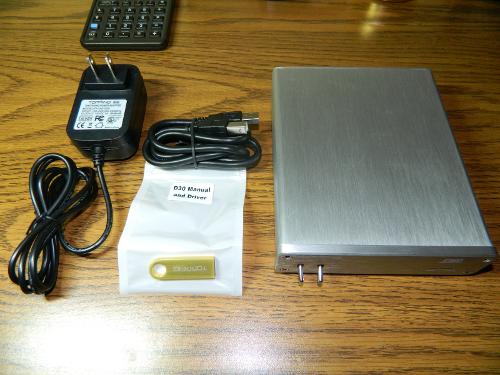
There is a switching 15V 1A power supply, nice thick USB cable, an USB drive (nice touch!) containing the driver, manual, and instructions, and the DAC itself. The specs are cribbed from Topping's web site.
|
|||||||||||||||||||||||||||||||||||||
Front view:
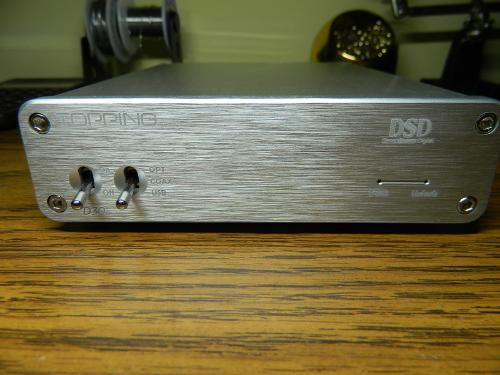
The interface is pretty minimal. A toggle switch for power. A toggle switch for input--optical, coax, and USB. 2 indicator lights, one for power on, and the other lights up for invalid file formats.
Back view:

RCA outputs, coaxial, optical, and USB inputs.
Compared to SMSL M8:
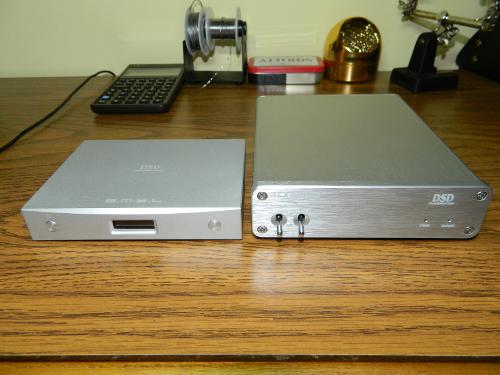
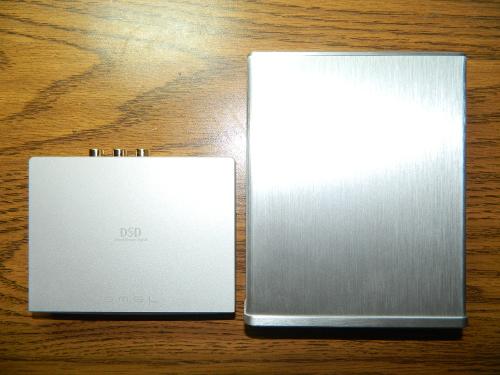
Gotta void the warranty:
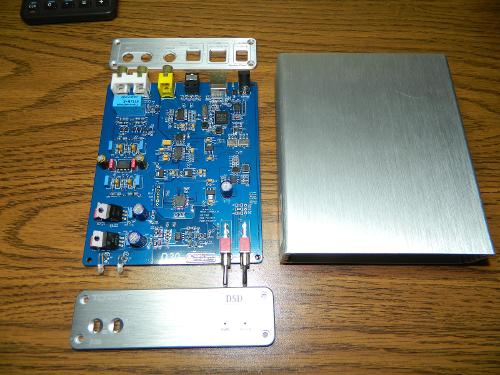
Closeups
The XMOS chip and oscillator crystals

Cirrus Logic CS4398

The output stage with the venerable OPA2134 opamp:
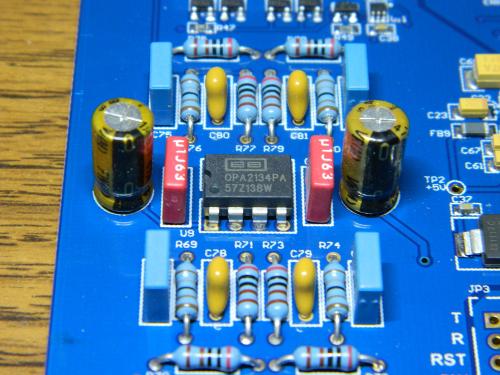
Output protection relay circuit, a very nice touch:

The internal components are very nicely done. The resistors appear to be KOA Speer 1% film resistors. The electrolytic caps are Elna's for the power section and Nichicon FW's for the opamp. The film caps are WIMA's and TDK-EPCOS. No complaints there.
So the questions is: How does it sound? Well, it sounds like nothing. Nothing at all. It takes the 0's and 1's from the source and convert them to analog signals without adding anything. It does not color the sound or add anything to the music. What you get is a pure, clean output, and that is the best compliment.
What are my gears? For cans, I used AKG K7xxx, Beyerdynamics DT990 600 Ohm, and Fostex TH500RP. I really like the TH500RP's. They got a bad rep for having rolled off trebles when they first came out, but I'm a bit treble sensitive and find them to be well balanced. The DT900's are only for electronic music because they are fun, and the AKG's, well, they are excellent all-around cans with the bonus factor that my wife think they look stupid and refuse to use them, so I don't have to fight her for it.
As far as amps go, I used an O2 of my own build and this:
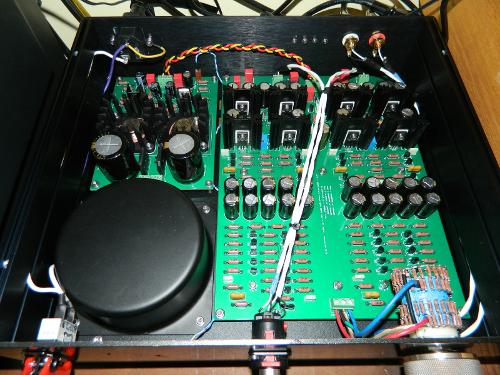
Also of my own build. I won't say anything about it, but if you know what it is, you'll know where I'm coming from.
So how does it compare with the SMSL M8?
Well, the D30 doesn't have the OLED display showing the format, or the fancy filters (which I haven't really been able to reliably tell any difference), but the sound is comparable. I find the M8 to be transparent, just like the D30. If you already have a M8, there is no point in getting the D30. But if you are looking for a DAC to start out that will handle DSD files, the Topping D30 is the deal of the century.
What are the downfalls? Well, it doesn't support 32/382, DXD or DSD 256/512, but since I don't have any music in those formats, it's a moot point.
Interestingly, with my Windows 10 rig, I was able to plug it in, and because I had the driver for the M8 installed, the computer recognized immediately. In fact, I didn't have to do anything to Foobar2000 since I already had it configured for the M8. Makes sense since both DAC's use the XMOS interface. The driver provided by Topping on the USB drive is the 2.26.0 version. The latest driver for the SMSL M8 is the 3.20.0 version, which is what I have installed.
One final note. Just to really, really void the warranty:

Oh, yeah, sucked off the 2134 and replaced it with a DIP-8 socket. I broke one on the pins on the 2134 while desoldering it, but no big deal. I have a couple of 2132's (which are higher grades of 2134's anyway) and popped one in. Sounded exactly the same. 2227 opamp was about the same as the 2132. I popped in a 2107 I had lying around, and MAYBE it sounded a bit fuller, but I can't reliably tell the difference, but since there is no distortion, I left the 2107 in because, well, it cost more .
One final, final note, I ordered the parts to build a 15V linear power supply and will post the results.
(Briefly about me: I'm in my mid 40's and consider myself a music enthusiast and a electronic hobbyist rather than an audiophile. In fact, I'm anything but an audiophile. My hearings are shot from years in a rock band, and I can't hear anything above 14 KHz.)



















เงื่อนไขอื่นๆ

ช่วง 7 วันแรกนับจากวันที่สินค้าถึงมือลูกค้า
กรณีที่สินค้าที่ได้ซื้อ มีปัญหาจากตัวสินค้าชำรุดเสียหายเนื่องจากการผลิต (สินค้า กล่อง และ อุปกรณ์เสริมต่างๆ ต้องอยู่ในสภาพสมบูรณ์ครบถ้วน ) สามารถเปลี่ยนสินค้าใหม่ได้ภายใน 7 วัน นับจากวันทีได้รับสินค้าตามเงื่อนไขการพิจารณาของทางบริษัท หากพ้นกำหนดนี้ บริษัทฯ จะรับเคลมสินค้าตามขั้นตอนปกติ
หลังจาก 7 วันนับจากวันที่สินค้าถึงมือลูกค้า
บริษัทฯ รับประกันสินค้าตามระยะเวลาที่ระบุไว้ในหน้าสินค้า นับจากวันที่ซื้อสินค้า ภายใต้เงื่อนไขภายใต้ระยะเวลาของการรับประกัน ของแต่ละยี่ห้อบริษัทฯอาจมีการซ่อมแซม เปลี่ยนสินค้า หรือเปลี่ยนสินค้าทดแทน (refurbish) ตามดุลยพินิจของทางบริษัท
เงื่อนไขข้อจำกัดการรับประกัน (Disclaimer)
บริษัทฯขอสงวนสิทธิในการจำกัดการให้บริการการรับประกันสินค้าในกรณีดังต่อไปนี้
1. ความเสียหายจากการใช้ผลิตภัณฑ์ผิดประเภท ละเลย หรือไม่ปฏิบัติตามคำแนะนำที่ระบุไว้บนกล่องผลิตภัณฑ์ และสูญหาย
2. การเสื่อมสภาพของวัสดุสิ้นเปลืองที่ไม่ส่งผลกระทบต่อการใช้งานของผลิตภัณฑ์ เช่น กระเป๋า,แจ็คสำหรับโทรศัพท์แต่ละรุ่น,สาย usb,จุกหูฟัง,สายเชื่อมต่อ ซึ่งลดน้อยลงไปตามระยะเวลาการใช้งาน
รวมถึงสายหูฟังที่มีการเสื่อมตามการใช้งานปกติ เช่นการปริแตก ขึ้นคราบเขียว สายเหนียว หรือการหลวมของขั่วต่างๆที่เกิดจาการใช้งาน
3. ความเสียหายอันเกินขึ้นกับวัสดุภายนอก เช่น การหัก บิ่น ถลอก งอ ยุบ เบี้ยว คราบสนิม หรือเป็นรอยขีดข่วน
4. การแกะ งัดแงะ ความพยายามในการซ่อม ดัดแปลง หรือแก้ไข โดยบุคคลหรือศูนย์บริการที่ไม่ได้รับการแต่งตั้งอย่างเป็นทางการโดยบริษัทฯ
5. ความเสียหายอันเนื่องมาจากอุบัติเหตุ เหตุอันเนื่องมาจากความประมาท หรือภัยธรรมชาติ
6. ความเสียหายหรืออาการผิดปกติอันเนื่องมาจากน้ำ ความชื้น ของเหลวใดๆ ความร้อน สภาพแวดล้อมที่รุนแรง หรืออาหารหกใส่ผลิตภัณฑ์
7.ความเสียหายที่เกิดจากการใช้งานผิดประเภท(Human cause) เช่น กระชากสายขาด ตกน้ำ ตกไฟ แมวข่วน หรือ อุบัติเหตุ
8.ความเสียหายที่เกิดขึ้นจากการ Burn in ผิดวิธี เช่นใช้เสียงสัญญาณ White noise , Pink noise หรือไฟล์เพลงคุณภาพต่ำ จนไดรเวอร์เกิดความเสียหาย
9.ไม่สามารถแสดงหลักฐานการซื้อเช่นใบแจ้งหนี้การซื้อ / ใบเสร็จรับเงินจาก Holysai หรือ ตัวแทนจำหน่ายสินค้าของHolysai ได้
10.ความเสียหายที่เกิดจากการใช้งานผิดประเภทของอุปกรณ์ประเภทกันน้ำที่มีมาตรฐานรับรอง IP , IPX ตามเงื่อนไขมาตรฐานการใช้งาน IP,IPX ตามประกาศอ้างอิงที่ https://www.holysai.com/article/40/
เงื่อนไขการรับประกัน
1. ภายใต้ระยะเวลาของการรับประกัน บริษัทฯ อาจทำการซ่อมหรือเปลี่ยนสินค้าตัวใหม่ให้ ทั้งนี้ขึ้นอยู่กับ ดุลยพินิจของบริษัทฯ
2. หลังจากซ่อมหรือเปลี่ยนสินค้า การนับระยะเวลารับประกันจะเริ่มนับต่อเนื่องจากที่เหลืออยู่
3. บริษัทฯ ขอสงวนสิทธิ์ในการคิดค่าใช้จ่ายในการซ่อมหรือเปลี่ยนสินค้า โดยขึ้นอยู่กับดุลยพินิจ ของบริษัทฯ
4. สินค้าที่ส่งเคลม จำเป็นต้องทิ้งเครื่องไว้เพื่อตรวจสอบความบกพร่องหรืออาการเบื้องต้นก่อน
5. บริษัทฯ จะไม่รับผิดชอบต่อสินค้าที่เสียหายที่อยู่นอกข่ายการรับประกัน หรือ สินค้าที่หมดประกันแล้ว
6. ระยะเวลาในการเคลมในกรณีที่ต้องส่งสินค้าไปทดสอบ หรือให้เจ้าของผลิตภัณฑ์เป็นผู้พิจารณา อาจใช้ระยะเวลาไม่เท่ากันตามขั้นตอนจองแต่ละยี่ห้อ
*หมายเหตุ
สินค้าประเภทหูฟัง รับประกันสายหูฟัง หรือ สายเปลี่ยนหูฟัง (Replacement Cable) รับประกันสินค้านาน 3 เดือนนับจากที่ซื้อ (เว้นแต่บางยี่ห้อที่ระบุระยะเวลาประกันไว้ตามด้านล่างอาทิเช่น KZ ) เงื่อนไขการประกัน สินค้าจะต้องอยู่ในสภาพสมบูรณ์ ไม่มีร่องรอยการเสื่อมสภาพ อาทิเช่น ฉีก ขาด ดัดแปลง แก้ไข คราบสนิม เปลี่ยนสี เกิดคราบเหนียว ขั่วหลวม ขั่วชำรุด ความเสียหายที่เกิดจากอุบัติเหตุต่างๆ และความเสียหายที่เกิดจากการใช้งานผิดประเภท
ระยะเวลาการรับประกัน
KZ = หูฟัง3เดือน(สายหูฟังทั้งที่มากับหูฟัง หรือ ซื้อแยก 1เดือน)
Seahf=6เดือน
Ty-hiz=6เดือน
TFZ= 1ปี (สายเชื่อมต่อต่างๆ 3เดือน)
Magaosi = หูฟัง 1ปี (สายเชื่อมต่อต่างๆ 3เดือน)
FiiO = 1ปี(สายเชื่อมต่อต่างๆ 3เดือน)
Soundmagic = 1ปี
Ostry = 1ปี
Yuin=1ปี
Hiby = 1ปี
Shanling=1ปี
Padmate = 1ปี
Mifo = 1ปี
Topping =1ปี
Auglamour = 6เดือน
VE = 1ปี (VE Monk 7วัน , VE Odyssey 1เดือน)
DD=6เดือน (เฉพาะสายเชื่อมต่อ และ แจ้คต่างๆ ไม่รวมถึงอุปกรณ์ประเภทเคสเสริม )
x-tips = 1เดือน
ฟองน้ำ = ไม่มีประกัน
อะไหล่ DIY= ไม่มีประกัน
หากลูกค้าสงสัยเงื่อนไขการรับประกันสินค้าข้อใด สามารถสอบถามเข้ามาโดยตรงได้ที่
Line @FiiO
Facebook.com/huufang
Email : Fiiogadget@Gmail.com
1. ชำระเงินผ่านร้านค้าโดยตรง
เลือกช่องทางที่คุณสะดวก เพื่อชำระเงินให้ร้านค้าโดยตรง หากมีข้อสงสัย กรุณา ติดต่อเรา
2. ชำระเงินออนไลน์ผ่าน 
เลือกช่องทางที่คุณสะดวก เมื่อชำระเงินเรียบร้อย คุณจะได้รับอีเมลยืนยันการชำระเงินทุกครั้ง (LnwPay ไม่มีค่าธรรมเนียมเพิ่มเติม อ่านรายละเอียด)



หมายเหตุ: สำหรับการชำระด้วยบัตรเดบิต (Debit Card) จำเป็นต้องสมัครใช้บริการจากธนาคารก่อนชำระเงิน ดูวิธีสมัคร ธ.กสิกร | ธ.กรุงเทพ | ธ.กรุงไทย



Your recently viewed items
CONTACT US
OUR PRODUCTS
RECOMMENDED ITEMS
NEW ARRIVAL
MEMBER ZONE
- ระดับ{{userdata.dropship_level_name}}
- ไปหน้าหลักตัวแทน
- ทั้งหมด {{(order_nums && order_nums.all)?'('+order_nums.all+')':''}}
- รอการชำระเงิน {{(order_nums && order_nums.wait_payment)?'('+order_nums.wait_payment+')':''}}
- รอตรวจสอบยอดเงิน {{(order_nums && order_nums.wait_payment_verify)?'('+order_nums.wait_payment_verify+')':''}}
- รอจัดส่งสินค้า {{(order_nums && order_nums.wait_send)?'('+order_nums.wait_send+')':''}}
- รอยืนยันได้รับสินค้า {{(order_nums && (order_nums.wait_receive || order_nums.wait_confirm))?'('+(order_nums.wait_receive+order_nums.wait_confirm)+')':''}}
- รอตรวจสอบข้อร้องเรียน {{(order_nums && order_nums.dispute)?'('+order_nums.dispute+')':''}}
- เรียบร้อยแล้ว {{(order_nums && order_nums.completed)?'('+order_nums.completed+')':''}}
- ทั้งหมด {{(order_nums && order_nums.all)?'('+order_nums.all+')':''}}
- รอการชำระเงิน {{(order_nums && order_nums.wait_payment)?'('+order_nums.wait_payment+')':''}}
- รอตรวจสอบยอดเงิน{{(order_nums && order_nums.wait_payment_verify)?'('+order_nums.wait_payment_verify+')':''}}
- รอจัดส่งสินค้า {{(order_nums && order_nums.wait_send)?'('+order_nums.wait_send+')':''}}
- ส่งสินค้าเรียบร้อยแล้ว {{(order_nums && order_nums.sent)?'('+order_nums.sent+')':''}}
OVERVIEW
| หน้าที่เข้าชม | 694,730 ครั้ง |
| ผู้ชมทั้งหมด | 337,291 ครั้ง |
| เปิดร้าน | 30 ก.ย. 2556 |
| ร้านค้าอัพเดท | 13 ธ.ค. 2568 |
 Soundmagic
Soundmagic






